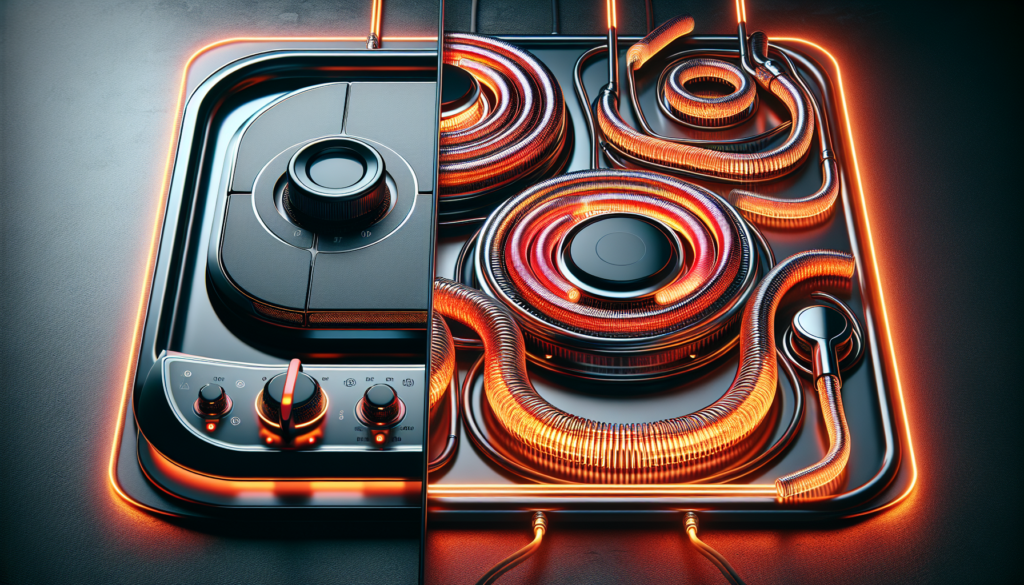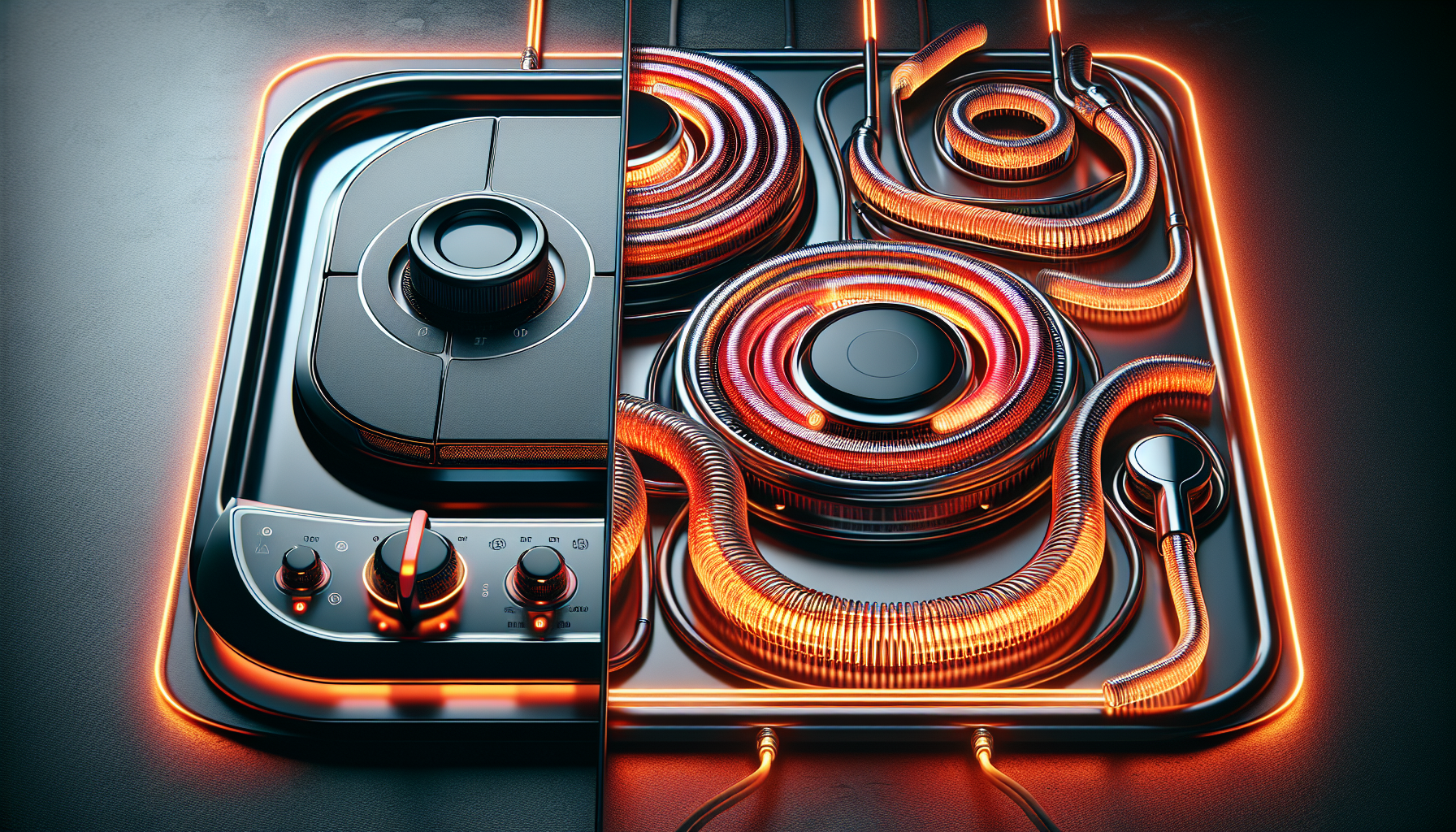Are you in the market for a new cooking appliance but feeling a bit confused about the various options available to you? Look no further! In this article, we will explore the key differences between an electric stove top and a hot plate. From functionality to portability, we will break down the unique qualities of these two cooking devices, helping you make an informed decision that suits your culinary needs. So, whether you’re a seasoned chef or a cooking novice, read on to discover which option is the perfect fit for your kitchen.

CHECK OUT COUNTERTOP BURNERS ON AMAZON
Size and Portability
Electric Stove Top
Electric stove tops come in various sizes, ranging from compact models suitable for small kitchens to larger ones that can accommodate multiple pots and pans simultaneously. The size of an electric stove top will depend on your needs and the available counter space in your kitchen. While they are more substantial than hot plates, electric stove tops are generally still portable, making them a versatile option for those who may need to move or rearrange their cooking setup.
Hot Plate
In contrast, hot plates are typically smaller and more lightweight than electric stove tops. They are perfect for limited spaces or for those who occasionally need an additional cooking surface. The compact size of hot plates makes them highly portable, so they can be easily moved and stored when not in use. Whether you live in a small apartment, dorm room, or want to take your cooking outside for a picnic or camping trip, a hot plate provides the flexibility and convenience you need.
Power Source
Electric Stove Top
As the name suggests, electric stove tops require an electrical power source. This means they need to be connected to an outlet or hardwired into your home’s electrical system. This makes electric stove tops a permanent fixture in your kitchen, as they cannot operate without access to electricity. However, this also means that they can provide a consistent and reliable source of heat, allowing for precise temperature control during cooking.
Hot Plate
Hot plates, on the other hand, are designed to be powered by electricity as well, but they are not permanently connected to a power source. They typically come with a power cord that can be plugged into a standard electrical outlet, making them a convenient option for those who may not have access to a built-in stove or require an additional cooking surface. The portability of hot plates makes them ideal for situations where you need a temporary cooking solution.
Installation
Electric Stove Top
Installing an electric stove top usually involves professional assistance. Unless you are experienced in electrical work and have the necessary tools, it is recommended to hire a certified electrician to ensure proper installation. This ensures that the stove top is safely connected to the electrical supply and meets all the necessary safety standards. Proper installation will also help avoid any electrical issues or damages in the long run.
Hot Plate
On the other hand, installing a hot plate is incredibly simple and does not require any professional assistance. Since hot plates are portable and designed to be used right out of the box, all you need to do is plug them into an electrical outlet, and they are ready to use. This user-friendly installation process makes hot plates an attractive option for those who need a quick and hassle-free cooking solution.
Heating Mechanism
Electric Stove Top
Electric stove tops typically feature electric coil burners or smooth ceramic glass surfaces. Electric coil burners consist of coiled metal elements that heat up when electricity flows through them. This type of heating mechanism provides even and consistent heat, ensuring uniform cooking. On the other hand, smooth ceramic glass surfaces utilize radiant heating technology, which distributes heat evenly across the surface. These smooth surfaces are not only aesthetically pleasing but also easy to clean.
Hot Plate
Hot plates generally come with either electric coil burners or induction heating technology. Electric coil burners on hot plates function similarly to those found on electric stove tops, offering uniform heat distribution. Induction hot plates, however, use magnetic currents to heat the cookware directly, bypassing the surface of the hot plate. This technology allows for faster heat-up times and precise temperature control. However, it is worth noting that induction hot plates may require specific types of cookware that are compatible with induction cooking.
Temperature Control
Electric Stove Top
Electric stove tops often come with temperature control knobs or buttons, allowing you to adjust the heat to your desired level. This provides a wide range of temperature options, giving you the flexibility to simmer, boil, or sear your food precisely. With clear temperature markings and easy-to-use controls, electric stove tops allow for convenient temperature adjustments during the cooking process.
Hot Plate
Hot plates, whether they have electric coil burners or induction technology, usually come with adjustable temperature settings as well. The control knobs or buttons allow you to increase or decrease the heat according to your needs. However, it is essential to note that temperature control on hot plates may not be as precise as on electric stove tops. Consequently, it may require a bit of experimentation and monitoring to achieve the desired cooking temperature.
Cooking Time
Electric Stove Top
Electric stove tops are known for their ability to provide consistent and even heat distribution. This feature helps reduce cooking time and ensures that your food is cooked thoroughly. Whether you’re boiling water for pasta or simmering a delicate sauce, electric stove tops can efficiently handle a wide range of cooking tasks, saving you valuable time in the kitchen.
Hot Plate
Hot plates can also cook food relatively quickly, especially if they utilize induction heating technology. The direct heat transfer to the cookware allows for faster and more efficient cooking. However, it’s important to remember that the size and power output of the hot plate can influence the overall cooking time. Additionally, the type of cookware you use and the heat settings selected may also affect the cooking time required.
Energy Efficiency
Electric Stove Top
Electric stove tops are generally considered less energy-efficient compared to other cooking methods, such as gas stoves or induction cooktops. The energy used by electric stove tops is primarily converted into heat, with some heat loss during the cooking process. However, advancements in technology have led to more energy-efficient electric stove tops, which can help conserve energy and reduce overall electricity consumption.
Hot Plate
Hot plates, particularly those with induction heating technology, are known for their energy efficiency. Since induction hot plates heat the cookware directly through magnetic currents, they offer faster heat-up times and use less energy compared to electric coil burners. This makes hot plates a more environmentally friendly option, as they minimize energy waste and reduce overall power consumption during the cooking process.
Cookware Compatibility
Electric Stove Top
Electric stove tops are compatible with a wide variety of cookware, including stainless steel, cast iron, ceramic, and glass. You have the freedom to choose the type of cookware that best suits your cooking needs and preferences. However, it’s important to ensure that your cookware is flat-bottomed and has a good heat-conducting base to maximize efficiency and prevent heat damage.
Hot Plate
Hot plates, especially those with induction heating technology, require specific types of cookware that are compatible with induction cooking. Induction hot plates rely on magnetic fields to heat the cookware, meaning it must be made of ferrous (magnetic) material, such as cast iron or certain types of stainless steel. Cookware made of aluminum, copper, or glass will not work on induction hot plates. It’s essential to check the compatibility of your cookware before using it on a hot plate to ensure optimal performance and safety.
CHECK OUT COUNTERTOP BURNERS ON AMAZON
Heat Distribution
Electric Stove Top
Electric stove tops are designed to distribute heat evenly across the surface of the burners or the ceramic glass. This uniform heat distribution ensures that your food cooks consistently, regardless of its position on the cooking surface. You can count on your dishes being cooked thoroughly and avoid any hot spots or unevenly cooked food.
Hot Plate
Hot plates, specifically those with induction technology, offer excellent heat distribution directly to the cookware. Induction heating creates a magnetic field that only affects the cookware, resulting in uniform heat distribution across the bottom of the pot or pan. This ensures your food gets cooked evenly and reduces the chances of burning or scorching, providing consistent results with every use.
Cost
Electric Stove Top
The cost of electric stove tops can vary depending on the brand, size, features, and overall quality. Typically, electric stove tops are considered a more significant investment compared to hot plates. Besides the purchase cost, you may also consider the installation expenses if professional assistance is required. However, electric stove tops often come with a longer lifespan and provide a reliable and efficient cooking experience, making them a worthwhile investment for your kitchen.
Hot Plate
Hot plates are generally more affordable compared to electric stove tops. Due to their compact size and simplicity, hot plates tend to have a lower price range. Additionally, since no professional installation is required, you can save on any associated costs. Hot plates offer a cost-effective solution for those who need an additional cooking surface or are on a tight budget. However, it’s important to consider the specific features and power output of the hot plate you choose to ensure it meets your cooking needs effectively.
In conclusion, the difference between an electric stove top and a hot plate lies in factors such as size and portability, power source, installation process, heating mechanism, temperature control, cooking time, energy efficiency, cookware compatibility, heat distribution, and cost. Depending on your kitchen setup, cooking needs, and budget, you can choose the option that best suits your requirements. Whether you decide on an electric stove top for its consistent heat or a hot plate for its portability, both offer convenient solutions for your cooking endeavors.
